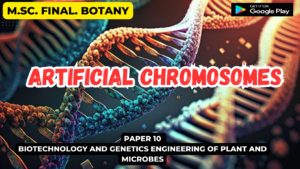![]()
Genetic Recombination in Phage
Genetic Recombination in Phage
- Site-specific genetic recombination is very common method in phage for exchanging the genetic material.
- Unlike general recombination it is guided by a recombination enzyme that recognizes specific nucleotide sequences present on one or both of the recombining DNA molecules.
- Base-pairing between the recombining DNA molecules need not be involved, and even when it is, the heteroduplex joint that is formed is only a few base pairs long.
- By separating and joining double-stranded DNA molecules at specific sites, this type of recombination enables various types of mobile DNA sequences to move about within and between chromosomes.

Figure 2.5: The formation of a cross-strand exchange.
- There are many possible pathways that can lead from a single-strand exchange to a cross-strand exchange, but only one is shown.
- Site-specific recombination was first discovered as the means by which a bacterial virus, bacteriophage lambda, moves its genome into and out of the E. coli chromosome.
- In its integrated state the virus is hidden in the bacterial chromosome and replicated as part of the host’s DNA (Figure 2.8).

Figure 2.8: The life cycle of bacteriophage lambda.
- The lambda genome contains about 50,000 nucleotide pairs and encodes about 50 proteins. Its double-stranded DNA can exist in either linear or circular forms.
- As shown, the bacteriophage can multiply by either a lytic or a lysogenic pathway in the E. coli bacterium.
- When the bacteriophage is growing in the lysogenic state, damage to the cell causes the integrated viral DNA (provirus) to exit from the host chromosome and shift to lytic growth.
- The entrance and exit of the DNA from the chromosome are site-specific genetic recombination events catalyzed by the lambda integrase protein.
- When the virus enters a cell, a virus-encoded enzyme called lambda integrase is synthesized.
- This enzyme catalyzes a recombination process that begins when several molecules of the integrase protein bind tightly to a specific DNA sequence on the circular bacteriophage chromosome.
- The resulting DNA-protein complex can now bind to a related but different specific DNA sequence on the bacterial chromosome, bringing the bacterial and bacteriophage chromosomes close together.
- The integrase then catalyzes the required DNA cutting and resealing reactions, using a short region of sequence homology to form a tiny heteroduplex joint at the point of union (Figure 2.5).
- The integrase resembles a DNA topoisomerase in that it forms a reversible covalent linkage to DNA wherever it breaks a DNA chain.
- The same type of site-specific recombination mechanism can also be carried out in reverse by the lambda bacteriophage, enabling it to exit from its integration site in the E. coli chromosome in order to multiply rapidly within the bacterial cell.
- This excision reaction is catalyzed by a complex of the integrase enzyme (Figure 2.6) with a second bacteriophage protein, which is produced by the virus only when its host cell is stressed.
- If the sites recognized by such a recombination enzyme are flipped, the DNA between them will be inverted rather than excised (Figure 2.7).
- Many other enzymes that catalyze site-specific recombination resemble lambda integrase in requiring a short region of identical DNA sequence on the two regions of DNA helix to be joined.

Figure 2.6: The insertion of bacteriophage lambda DNA into the bacterial chromosome.
- In this example of site-specific recombination, the lambda integrase enzyme binds to a specific “attachment site” DNA sequence on each chromosome, where it makes cuts that bracket a short homologous DNA sequence; the integrase thereby switches the partner strands and reseals them so as to form a heteroduplex joint 7 base pairs long.
- Each of the four strand-breaking and strand joining reactions required resembles that made by a DNA topoisomerase, inasmuch as the energy of a cleaved phosphodiester bond is stored in a transient covalent linkage between the DNA and the enzyme.
- Because of this requirement, each enzyme in this class is fastidious with respect to the DNA sequences that it recombines, and it can be expected to catalyze one particular DNA joining event that is useful to the virus, plasmid, transposable element, or cell that contains it.
- These enzymes can be exploited as tools in transgenic animals to study the influence of specific genes on cell behavior.
- Figure 2.7: Switching gene expression by DNA inversion in bacteria.
- Alternating transcription of two flagellin genes in a Salmonella bacterium is caused by a simple site-specific recombination event that inverts a small DNA segment containing a promoter that in one orientation (A) activates transcription of the H2 flagellin gene as well as a repressor protein that blocks the expression of the H1 flagellin gene.
- When the promoter is inverted, it no longer turns on H2 or the repressor, and the H1 gene, which is thereby released from repression, is expressed instead (B).
- The recombination mechanism is activated only rarely (about once every 105 cell divisions). Therefore, the production of one or other flagellin tends to be faithfully inherited in each clone of cells.
- Site-specific recombination enzymes that break and rejoin two DNA double helices at specific sequences on each DNA molecule often do so in a reversible way: as for lambda bacteriophage, the same enzyme system that joins two DNA molecules can take them apart again, precisely restoring the sequences of the two original DNA molecules. This type of recombination is therefore called conservative site-specific recombination to distinguish it from the mechanistically.



